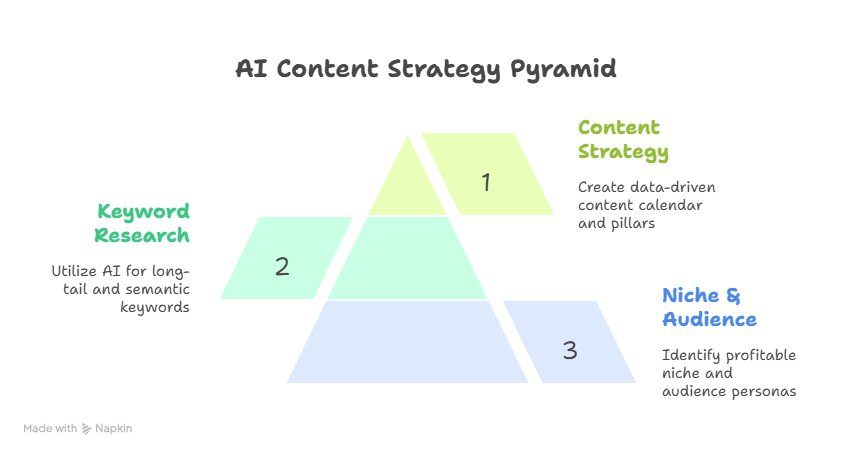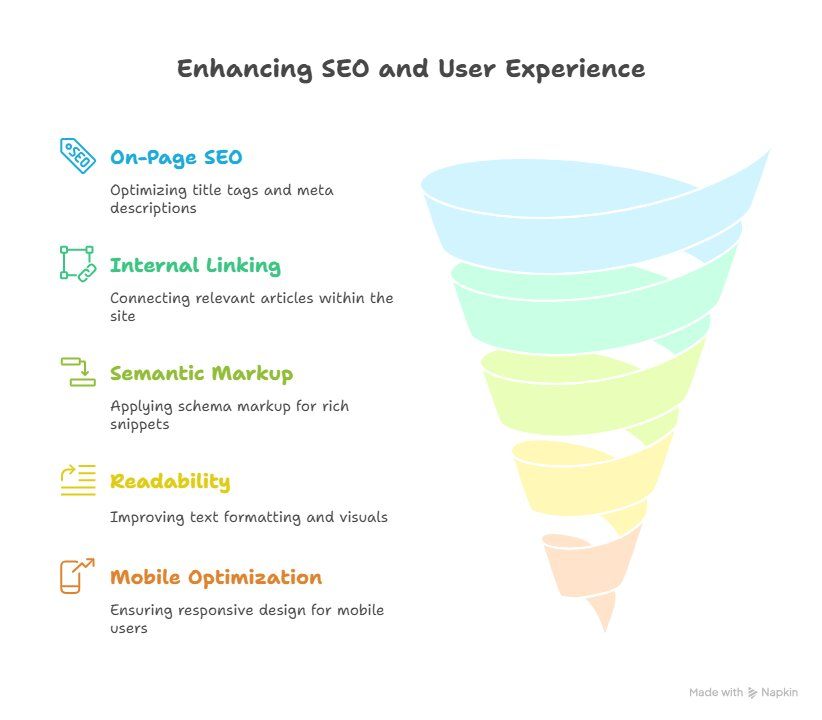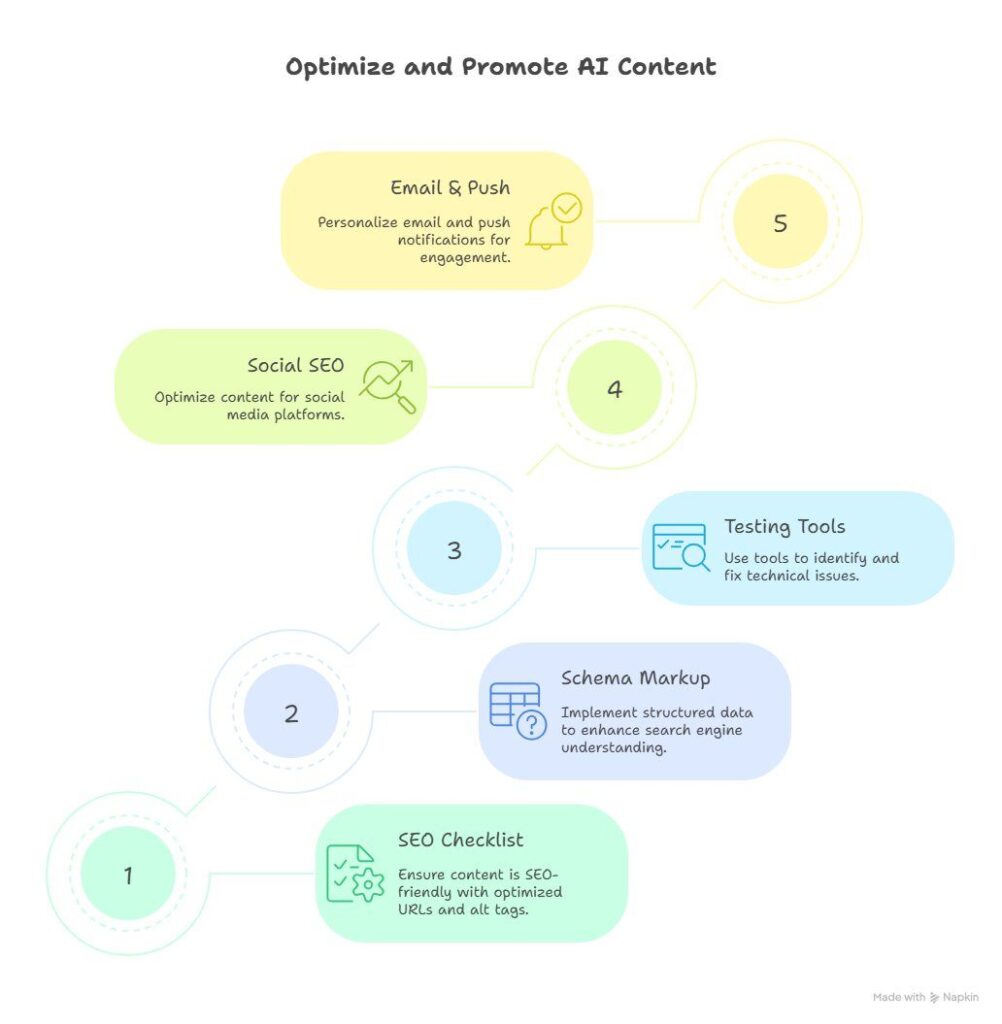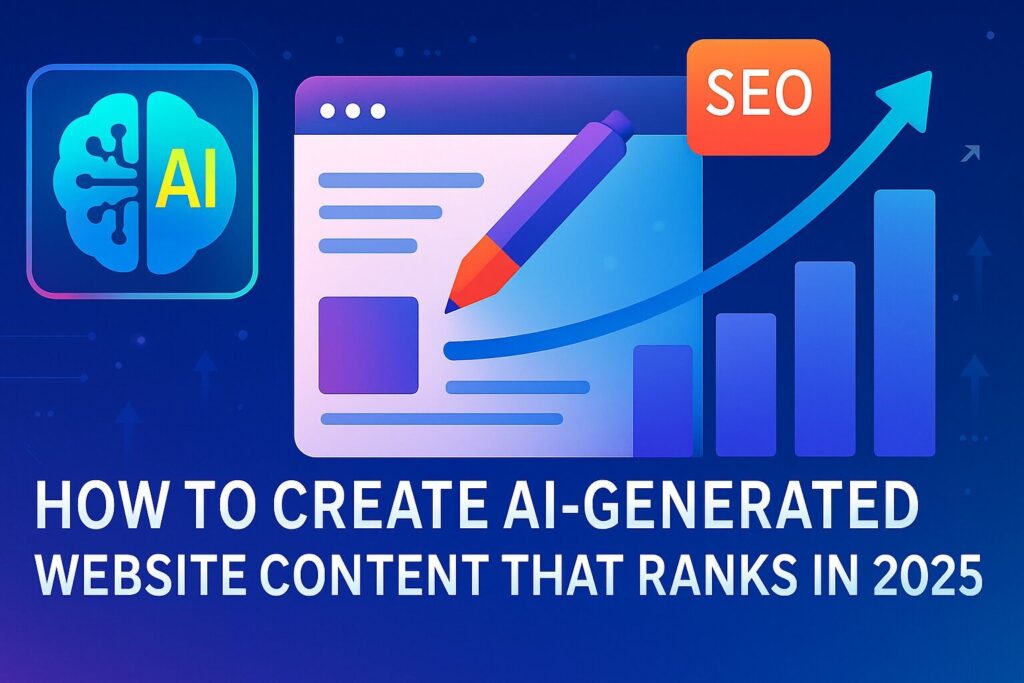Table of Contents
Introduction
Why AI Content Creation Is the Future
Imagine having a tireless writing partner that can brainstorm ideas at 3 a.m., draft outlines in seconds, and tailor tone with the click of a prompt. That’s the promise of AI-powered content creation. As businesses scramble to keep up with the demand for fresh, engaging material, AI steps in to supercharge creativity, streamline workflows, and help us break through the blank-page paralysis that plagues many writers. No longer is AI simply a novelty; in 2025, it’s the backbone of agile content teams, enabling solopreneurs and agencies alike to publish at scale without sacrificing quality or authenticity.
The Evolution of Search Engines and Content Ranking (2023–2025)
Over the past two years, search engines have transformed from keyword-driven engines to context-aware, intent-hunting platforms. In 2023, Google began leaning heavily on machine learning models to interpret user queries beyond mere word matches, ushering in a wave of sophisticated updates that prioritize quality over keyword stuffing. Fast forward to 2025, and we’re witnessing the rise of content experiences tailored to individual contexts—voice assistants that summarize articles on the fly, AI-driven answer boxes that pull from multiple sources, and ranking algorithms that reward originality and expertise. Understanding this rapid shift is crucial: your content must not only tick SEO checkboxes but also deliver real value that resonates with both algorithms and humans.
Part 1: Understanding the New SEO Landscape
1.1 The Shift to EEAT and Human-Like Content
What Is EEAT and Why It Matters More Than Ever
EEAT—Expertise, Experience, Authoritativeness, and Trust—has become the golden metric by which search engines judge content credibility. In an era awash with AI-generated text, EEAT separates the wheat from the chaff. Demonstrating genuine expertise means weaving in first-hand insights, case studies, or real-world data that only humans can provide. Experience underscores your direct interaction with the subject matter—think personal anecdotes or user testimonials.
Authoritativeness emerges when respected voices in your niche vouch for your content, perhaps through guest quotes or citation of peer-reviewed research. Finally, trust is built through transparency: clear sourcing, honest disclosures, and consistent brand voice. Together, these elements ensure that AI doesn’t just produce words, but crafts a trustworthy narrative that readers—and search engines—can rely on.
Google’s Focus on Real Experience & Accuracy
As AI tools have proliferated, Google has doubled down on rewarding content that reflects actual expertise and lived experience. Rather than merely scanning for keyword density, modern ranking systems assess whether content demonstrates a nuanced grasp of its topic. Does your article cite precise statistics? Does it link to reputable studies? Does it show you’ve rolled up your sleeves and tested solutions yourself? This pivot towards accuracy means that AI-generated drafts must be rigorously reviewed, fact-checked, and enriched with authentic human perspective. The result is a symbiotic dance: AI accelerates the writing process, but human insight steers the content toward honesty and depth.
1.2 How Search Engines Analyze AI Content in 2025
Natural Language Processing and Semantic SEO
By 2025, Natural Language Processing (NLP) has matured to the point where search engines “understand” meaning rather than just matching keywords. Semantic SEO has risen, emphasizing related terms, synonyms, and topic clusters that mirror how humans naturally converse. AI content must therefore be structured around concepts, not just target phrases. A single blog post might intelligently weave together primary keywords, latent semantic indexing (LSI) terms, and user-centric questions—all designed to signal topical relevance to sophisticated NLP algorithms. This ensures your content not only ranks for primary queries but also surfaces in related searches and voice assistant answers.
The Rise of Search Generative Experience (SGE)
Search Generative Experience represents the next frontier: instead of presenting a list of blue links, search engines synthesize answers from diverse sources into cohesive, conversational summaries. In practice, SGE can propel well-organized, AI-assisted content into prime visibility—but only if it’s comprehensive and structured for easy extraction. That means clear headings, concise paragraphs, and bullet points when appropriate. By anticipating the way search engines pull snippets for SGE responses, you can craft your content to become the very text that Google repurposes, driving both direct traffic and enhanced credibility.
Part 2: Laying the Foundation for Rankable AI Content

2.1 Niche and Audience Research
Identifying a Profitable and Searchable Niche
Before firing up your favorite AI assistant, lock in on a niche that balances passion, expertise, and market demand. Begin by surveying keyword volume data and competitive gaps: is there a segment of “sustainable graphic design templates” that’s underserved? Can you carve out authority in a sub-niche, like “AI-generated podcast show notes”? This targeted focus not only improves your chance of ranking but also aligns content creation with real business objectives—whether that’s affiliate revenue, lead generation, or brand awareness.
Creating Audience Personas with AI Tools
Once your niche is defined, deploy AI to flesh out audience personas. Prompt ChatGPT or similar models to draft profiles of your ideal readers: their demographics, pain points, preferred formats, and digital hangouts. These personas anchor your strategy, guiding tone, style, and distribution. For example, an audience persona—“Eco-conscious Entrepreneur Emma, aged 32”—might skew toward visual guides and actionable checklists shared on Instagram and LinkedIn. By feeding these insights back into your AI prompts, you ensure each piece of content resonates deeply with the people who matter most.
2.2 Strategic Keyword Research in 2025
Long-Tail Keywords, Clusters, and Semantic Variants
Gone are the days of optimizing for a single high-volume keyword. Today’s SEO thrives on long-tail phrases and thematic clusters that capture niche intent. Rather than competing head-to-head for “AI content tools,” aim for “best AI content tools for affiliate marketing” or “how to use AI to write product descriptions.” Organize these keywords into clusters—primary, secondary, and related modifiers—to build comprehensive content hubs that reinforce topical authority and improve cross-linking opportunities.
Using AI Tools like ChatGPT, Surfer SEO, and NeuronWriter
Leverage the synergy of multiple AI platforms. ChatGPT can ideate headline variations and draft conversational intros, while Surfer SEO provides real-time analysis of top-ranking pages, suggesting ideal word counts, keyword densities, and structural patterns. NeuronWriter, meanwhile, excels at semantic optimization, highlighting gaps in your content compared to competitors. By combining these specialized tools, you create a feedback loop: AI drafts, data-driven insights refine, and you iterate toward a piece that’s both reader-friendly and algorithm-approved.
2.3 Creating a Data-Driven Content Strategy
Content Calendars, Pillars, and Topic Clusters
A robust content strategy begins with a well-structured calendar that maps out pillar posts and supporting cluster articles. Pillars cover broad, high-value topics (e.g., “Ultimate Guide to AI Content Creation”) while clusters delve into subtopics (“Top 5 AI Prompting Techniques for E-commerce Copy”). This architecture not only aids user navigation but also signals to search engines that your site offers comprehensive coverage of key themes.
Matching User Intent with Every Post
At the heart of engagement and SEO lies intent matching: aligning the purpose of each piece—whether informational, transactional, navigational, or commercial investigation—with the stage of the buyer’s journey. Use AI to tag potential queries by intent, then ensure your content’s format and depth suit that intent. A quick-answer “how-to” snippet satisfies early-stage explorers, whereas a detailed case study or comparison chart caters to decision-ready prospects. When AI-driven content aligns perfectly with user needs, you earn higher dwell time, lower bounce rates, and, ultimately, stronger search rankings.
Part 3: AI Content Creation Best Practices
3.1 Choosing the Right AI Tools
Comparison of ChatGPT, Jasper, Claude, Gemini, etc.
With so many AI writing assistants on the market, it’s tempting to jump in and try them all—but understanding their unique strengths will save you time and money.
ChatGPT excels at open‑ended brainstorming and conversational tone; its versatility makes it my go‑to for first drafts and outline generation. Jasper often shines when you need tightly optimized copy—its built‑in SEO and brand voice settings can crank out landing‑page text in minutes.
Claude is particularly adept at nuanced reasoning and longer‑form content, handling complex topics with a steadier hand.
Gemini, Google’s latest, integrates seamlessly with Google Workspace and can pull in real‑time facts, making it ideal for data‑driven pieces. In practice, the smartest approach is to lean on each tool for what it does best: brainstorm in ChatGPT, refine with Jasper’s SEO bias, vet logic in Claude, and fact‑check via Gemini or another real‑time API.
When to Use Which Tool
- Brainstorming & Outlines: ChatGPT. Its free‑flowing style cracks creative logjams and helps you map structure quickly.
- SEO‑Optimized Copy: Jasper. If you need built‑in keyword suggestions, readability scores, and tone presets, Jasper speeds the process.
- Deep Dives & Research Synthesis: Claude. When your article demands logical rigor or must weave together disparate sources, Claude handles complexity elegantly.
- Fact‑Checking & Real‑Time Updates: Gemini (or similar). To ensure statistics, news references, and market data are current, use a tool with live data integration.
3.2 Crafting Engaging, Human-Like Drafts
Prompts That Produce Natural and Rankable Content
The secret to a stellar AI draft is in the prompt. Instead of “Write a blog post about time management,” try:
“Generate a conversational 800‑word blog post for solopreneurs on ‘5 unconventional time‑management hacks.’ Use a friendly tone, include a personal anecdote about juggling social media tasks, and pepper in relevant long‑tail keywords like ‘AI time management tools for entrepreneurs.’”
This level of detail primes the AI to deliver natural, context‑rich content that already ticks many SEO boxes.
Integrating Emotion, Stories, and Examples in AI Output
Readers connect with stories far more than they do with dry facts. Encourage your AI to weave in emotional beats:
- Anecdotes: “Describe a morning when you missed a key deadline because of inbox overwhelm.”
- Vivid Imagery: “Paint a scene of a cluttered desk at 7 a.m.”
- Relatable Struggles: “Explain the frustration of toggling between ten tabs.”
By embedding prompts like this, you ensure the AI output feels lived‑in, authentic, and memorable—qualities that both humans and search engines reward.
3.3 Using AI for Different Content Types
Blog Posts
Leverage AI to brainstorm catchy titles, generate outlines, and draft sections. Ask it for bulleted lists of statistics, and then weave those into your narrative to bolster credibility.
Product Descriptions
AI can rapidly spin multiple versions of descriptions tailored to different buyer personas. Prompt it to focus on features and benefits, and to include short customer testimonials or star‑rating highlights.
Landing Pages
Here, clarity and persuasion reign. Use AI to A/B test headlines, craft punchy subheads, and draft concise CTAs. Instruct the model to follow a known framework—like PAS (Problem‑Agitate‑Solve)—to ensure logical flow.
Tutorials & Guides
Break complex processes into numbered steps with clear headings. AI excels at generating step‑by‑step instructions; follow up with your own screenshots or personal tips to deepen the reader’s trust.
Part 4: Optimization for Search Engines and Humans

4.1 On-Page SEO Essentials
Title Tags, Headers, and Meta Descriptions
Ensure your primary keyword appears in the title tag within the first 60 characters. Use <h1> for your main title, and <h2>/<h3> for subsections to create a clear hierarchy. Meta descriptions should be 150–160 characters long, include the keyword, and offer a compelling reason to click—think of it as your ad copy in the search results.
Internal Linking and Semantic Markup
Link to relevant articles within your site—this spreads link equity and helps Google understand your topic clusters. Apply schema markup (e.g., Article, HowTo, FAQ) so search engines can more easily surface rich snippets that boost click‑through rates.
4.2 Readability and User Experience
Using Formatting, Visuals, and CTAs
Break up dense text with bullet points, numbered lists, and bolded keywords. Embed infographics or charts near data‑heavy sections to reinforce key insights. End each major section with a call‑to‑action—whether it’s to read another post, sign up for a newsletter, or download a cheat sheet—to guide the reader’s journey.
Optimizing for Mobile and Voice Search
Over half of all searches now happen on mobile devices. Keep paragraphs under three lines, use larger font sizes, and ensure images scale responsively. For voice search, incorporate natural question phrasing (“How do I use AI for content?”) and concise answers in the first few sentences.
4.3 Fact-Checking and Originality
Detecting and Fixing AI Hallucinations
AI can sometimes invent quotes or stats—so always verify any factual claims. Cross‑check numbers against reputable sources, and remove or correct anything that can’t be substantiated.
Adding Human Edits, Insights, and Unique Value
After the AI draft is complete, infuse your own observations. Share lessons learned from personal projects, interview industry peers for fresh quotes, or conduct small surveys to gather unique data. These human touches elevate your content from generic to gold‑standard.
Part 5: Enhancing Content with Multimedia and AI Tools
5.1 Visual Content That Supports SEO
AI Tools for Infographics, Charts, and Featured Images
Platforms like Canva’s Magic Design or Adobe Firefly can auto‑generate branded visuals, while Chartbrew or Flourish create interactive charts in minutes. Eye‑catching images not only improve dwell time but also have their own SEO potential when optimized with descriptive alt text.
Embedding Videos and Podcasts for Engagement
Host short explainer videos on YouTube and embed them within your article to cater to visual learners. Use AI transcription services to generate captions and transcripts, which you can publish below the video for improved accessibility and additional keyword fodder.
5.2 Interactive and Personalized Content
Quizzes, AI Chatbots, and Calculators
Engagement widgets—like “Which AI writing persona are you?” quizzes—keep readers on your page longer. Tools such as Typeform or Outgrow let you build interactive surveys, while chatbot platforms like Landbot can guide users toward relevant content based on their answers.
Hyper-Personalization with Dynamic Content
By integrating your CMS with AI‑powered personalization engines (e.g., OneSpot, RightMessage), you can swap out headlines, images, or CTAs based on a visitor’s behavior or demographics. This tailored experience not only boosts conversions but also sends positive signals to search engines about user satisfaction.
With these best practices and optimization strategies in your toolkit, you’re well on your way to harnessing the full power of AI for content that not only ranks but also deeply resonates with your audience.
Part 6: Publishing and Promoting Your AI Content

6.1 SEO-Friendly Content Upload Checklist
URL Structure
Keep your URLs short, descriptive, and keyword‑rich. For example, use /ai-content-upload-checklist rather than /post?id=123. This helps both users and search engines understand what the page is about at a glance. Separate words with hyphens, avoid stop words where possible, and include your primary keyword near the beginning.
Image Alt Tags
Every image should have a concise, descriptive alt tag that incorporates relevant keywords naturally. For instance, alt=”infographic showing AI content workflow”. Alt tags improve accessibility for visually impaired visitors and give search engines extra context for image optimization and potential ranking in image search.
Schema Markup
Implement structured data (Schema.org) to help search engines interpret your content. For a blog post, use the Article schema. If you include a FAQ section, wrap each question and answer in FAQPage markup. This can unlock rich results like knowledge panels and FAQ snippets, boosting your visibility in the SERPs.
Tools for Testing Before Publishing
- Google’s Rich Results Test: Verify your schema markup and preview potential rich snippets.
- PageSpeed Insights or Lighthouse: Identify performance bottlenecks on desktop and mobile.
- Mobile-Friendly Test: Ensure your page renders and functions smoothly on smartphones and tablets.
- SEO Site Audit Tools (e.g., Screaming Frog, Ahrefs): Check for broken links, missing meta tags, duplicate content, and other technical issues.
6.2 Promotion Strategies in 2025
Social SEO on Platforms Like Threads, TikTok & Pinterest
Social media platforms have become search ecosystems in their own right. On Threads, optimize your first sentence with a keyword or question—users often scroll rapidly, so hook them immediately. On TikTok, pair short explainer videos with on‑screen captions containing your target phrase, and include descriptive hashtags. Pinterest functions like a visual search engine: craft pins with keyword‑rich titles and descriptions, and link directly back to your article.
Email, Web Push, and AI-Powered Newsletters
Segment your email list based on interests and past behavior, then use AI to personalize subject lines and preview text. For example, “Amy, discover 5 AI hacks to write smarter this week.” Web push notifications can deliver brief, urgent updates like “New guide: How to optimize your AI content for Google—read now!” AI‑powered newsletter platforms (e.g., Mailchimp’s Content Optimizer) can suggest the best send times, headlines, and article snippets for maximum engagement.
Part 7: Monitoring Performance and Iterating
7.1 Tools for Measuring Success
GA4
Use Google Analytics 4 to track user engagement metrics such as time on page, scroll depth, and conversion events. Set up custom dashboards that highlight the performance of your AI‑generated content versus human‑written benchmarks.
Search Console
Monitor impressions, clicks, and average positions for each URL. Pay attention to queries that are gaining traction—this can spark ideas for new cluster topics or identify keywords you might optimize further.
Rank Trackers
Tools like Ahrefs, SEMrush, or AccuRanker can automatically track your target keywords’ positions across devices and locations. Set alerts for dramatic drops so you can investigate technical issues or content decay.
AI-Based Analytics Tools and Alerts
Platforms such as ContentKing or Frase can continuously crawl your site and use AI to spot anomalies—for instance, sudden traffic dips or missing metadata—and send real‑time alerts so you can react swiftly.
7.2 Updating and Refreshing AI Content
When to Refresh for SEO Wins
Audit your posts every 6–12 months. Refresh pages that have lost ranking, have outdated statistics, or cover rapidly evolving topics. Look for content that still attracts impressions but has a low click‑through rate—often a quick title or meta description tweak can reignite interest.
Using AI to Re-optimize Existing Pages
Leverage AI to generate new subheadings, rewrite underperforming sections, or craft updated summaries. Prompt your AI tool with:
“Rewrite paragraphs 4–6 to include the latest 2025 statistics on AI content adoption, using a friendly tone and preserving the original meaning.”
This hybrid approach keeps your content fresh, accurate, and aligned with current search intent.
Conclusion
The future of content creation lies in a harmonious blend of AI efficiency and human ingenuity. AI turbocharges research, drafting, and optimization, but it’s the human touch—your unique insights, narrative flair, and ethical responsibility—that ultimately connects with readers and earns search engines’ trust.
Action Plan: Start Creating Smarter, Faster, and Better
- Select Your Toolkit: Pick the right AI platforms for ideation, drafting, and fact-checking.
- Plan with Precision: Map out a content calendar featuring pillar posts and clusters.
- Draft with Intention: Use detailed prompts to generate engaging, SEO-friendly drafts.
- Optimize Thoroughly: Follow on-page, multimedia, and promotion best practices.
- Monitor & Iterate: Regularly review performance data and refresh your content with AI and human edits.
By following this roadmap, you’ll harness AI’s speed without sacrificing the authenticity and expertise that keep audiences coming back.
FAQs
Q1: Is AI content still penalized by Google in 2025?
No—Google’s guidelines don’t penalize AI-generated content per se; they reward content that demonstrates EEAT. As long as your AI-assisted work is accurate, insightful, and adds genuine value, it stands on equal footing with fully human-written material.
Q2: How can I make my AI-generated content sound more human?
Infuse personal anecdotes, rhetorical questions, and conversational transitions. Always review and tweak the tone manually, adding your voice, humor, or unique phrasing to bring warmth and authenticity.
Q3: What’s the best AI content tool for SEO?
It depends on your needs. Jasper offers strong built-in SEO features, while Surfer SEO and NeuronWriter excel at real-time on-page analysis. Pair these with ChatGPT or Claude for drafting and research.
Q4: How do I avoid duplicate or generic AI content?
Customize your prompts extensively and review outputs for originality. Add proprietary data, case studies, and first-hand examples. Run drafts through plagiarism checkers and semantic uniqueness tools before publishing.
Q5: Can I rank without backlinks using AI content?
While high-quality backlinks accelerate ranking, you can still rank niche or long-tail posts through impeccable on-page optimization, topical authority, and a strong internal linking strategy.
Q6: How long should my AI-generated blog post be for SEO?
Aim for 1,200–2,000 words for comprehensive coverage of most topics, but let intent guide length. If it’s a deep tutorial or resource guide, 3,000+ words may be justified—just ensure you maintain clarity and engagement throughout.
Q7: Should I disclose AI-generated content on my site?
Transparency builds trust. Consider a small disclosure—“This article was drafted with AI assistance and reviewed by our editorial team”—to inform readers and demonstrate your commitment to accuracy and ethics.

